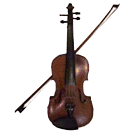

 |
Chord diagrams or fretboard diagrams are used with chord symbols in stringed instruments like guitar, banjo and ukulele.
Below they are written right of the corresconding chord-symbol.

Automated chord diagrams
MusiCAD allows you to use pre-defined diagrams that can be shown as a result of the tunes' chord symbols.
A file chorddiagrams.mcd contains common diagrams for a bunch of instruments.
|
code |
instrument |
tuning |
|
uke |
ukulele |
g-c-e-a |
|
mandolin |
mandolin / mandola |
g-d-a-e |
|
git |
simple guitar (without barré) |
e-a-d-g-b-e |
|
guitar |
guitar |
e-a-d-g-b-e |
|
banjo |
tenor banjo |
c-g-a-d |
|
tambura |
Bulgarian tambura |
d-g-b-e |
|
panduri |
Georgian panduri |
a-c#-e |
|
baglamas |
Greek baglamas / trichordo |
d-a-d |
|
bouzouki |
Greek tetrachordo bouzouki |
c-f-a-d |
The file itself is a plain text file that can be edited at [Options|Preferences|Files|Chord diagrams]
Enter the code of one of the listed instruments on the instrument section of the part properties dialog and you'll be presented with the chord diagrams corresponding to the chord symbols.
Use the text-style chord diagrams in the text dialog to select a style (position, color, size) for displaying your chord-diagrams.
The layout toolbox has a template to accomodate everything in one click.
Manual chord diagrams
MusiCAD comes with a specially designed font (MCDiagrams) to create these chord diagrams.
Manual diagrams are composed by writing sequences of digits

1 2 3 4 5
The special characters 0 and x represent an open string and a not-to-be-used string

The first diagram is created using 3211, the second with x00232.
To enter a manual diagram, use the tools button during edit, or the shortcut <ctrl-alt-shift [>
see also:


